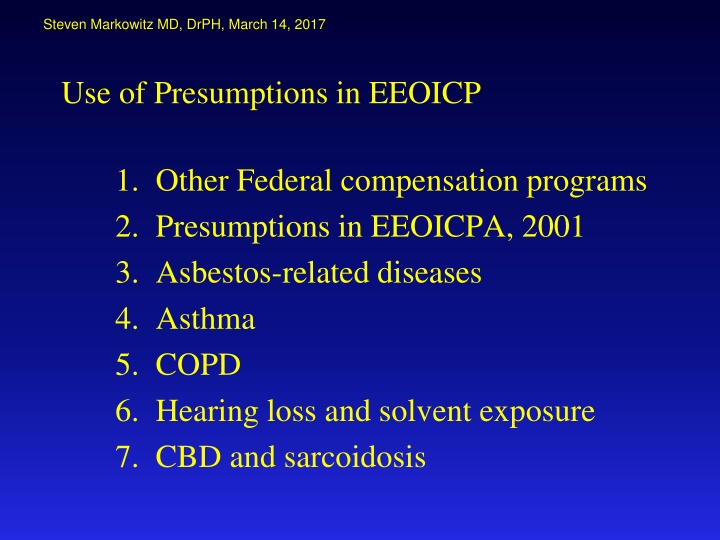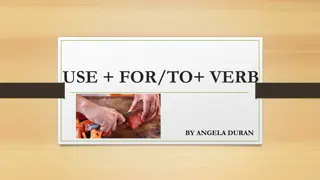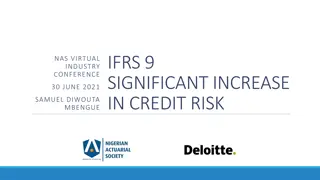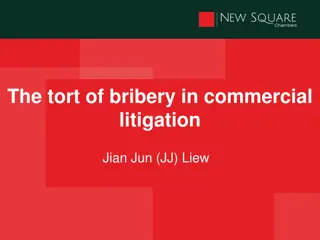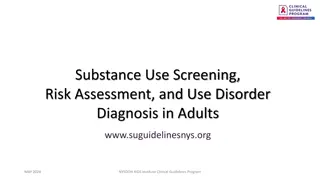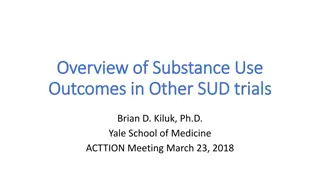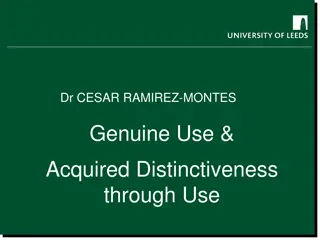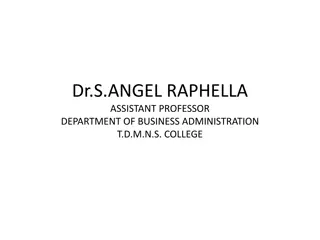Use of Presumptions in EEOICP
In this comprehensive document, Dr. Steven Markowitz explores the use of presumptions in various Federal compensation programs, focusing on asbestos-related diseases, asthma, COPD, hearing loss, solvent exposure, and more. The content delves into specific exposure criteria, occupation-related presumptions, calendar time durations, and disease diagnostic criteria. It also covers aspects of the Energy Employees Occupational Illness Compensation Program Act, including exposure presumptions for special cohorts and silica exposure. Additionally, the materials provide insights on the procedures and circulars related to asbestos under the EEOICP. A valuable resource for understanding eligibility and compensation in cases of occupational illness and exposure.
Download Presentation

Please find below an Image/Link to download the presentation.
The content on the website is provided AS IS for your information and personal use only. It may not be sold, licensed, or shared on other websites without obtaining consent from the author.If you encounter any issues during the download, it is possible that the publisher has removed the file from their server.
You are allowed to download the files provided on this website for personal or commercial use, subject to the condition that they are used lawfully. All files are the property of their respective owners.
The content on the website is provided AS IS for your information and personal use only. It may not be sold, licensed, or shared on other websites without obtaining consent from the author.
E N D
Presentation Transcript
Steven Markowitz MD, DrPH, March 14, 2017 Use of Presumptions in EEOICP 1. Other Federal compensation programs 2. Presumptions in EEOICPA, 2001 3. Asbestos-related diseases 4. Asthma 5. COPD 6. Hearing loss and solvent exposure 7. CBD and sarcoidosis
Program/ Aspects Presumed Exposure Occupation/ Individual Calendar Time Duration Time Place Miners, construction workers, & transportation workers. For presumption, 10 years minimum with 15 and 25 year clauses. Black Lung Program Coal dust N/A Coal dust related work areas. VCP WTC Fatalities, injuries, and/or dust from the debris. Respondents and non- respondents living in the area. Sept 11, 2001 to July 31st, 2002 at ground zero. Varies. No minimum or maximum. NYC Ground Zero, Pentagon site, Shanksville, PA site, barges or Fresh kills, or being killed due to the plane crash. Between 1945 and 1962 (atmosphere tests), before Jan. 1, 1974 (Amchitka Island, AK), before Feb. 1, 1992 (Gaseous plants), or during occupation/nuclear bombing of Japan. Atomic Veterans Comp. Ionizing radiation Alaska, Japan, atmospheric, and test sites. Veterans N/A Between January 9, 1962 and May 7, 1975 (Vietnam) & between April 1, 1968 and August 31, 1971 (Korean DMZ.) Agent Orange (blend of dioxin containing herbicides.) Vets Agent Orange Comp. N/A Veterans Vietnam and Korean DMZ. Chemical and environ agents (vaccinations, pyridostigmine bromide, pesticides, depleted uranium, infectious diseases, oil well fires, etc.) Gulf War Theater. (Iraq, Kuwait, Saudi Arabia, the neutral zone between Iraq and Saudi Arabia, Bahrain, Qatar, United Arab Emirates, Oman, sea and airspace.) Gulf War Comp. August 2, 1990 to present. Veterans N/A
EEOICPA Exposure presumptions in Act 1. Special exposure cohort: > 250 days work in GDP before 2/1/92 in a job where dosimetry monitoring was performed or in comparable job 2. Silica exposure: was present > 250 days during mining of tunnels at DOE facility in NV or AK
Presumption elements Exposure: Duration Job title (proxy for intensity and frequency) Calender years Latency Disease: diagnostic criteria
Exposure Presumptions, Part B in EEOICPA, 2000 Exposure criteria Cancer Silica Comments Duration > 250 days > 250 days NTS, Amchitka Job title If dosimetry was performed or comparable job present during mining When mining was active Calender years Before 2/92 Latency - -
Asbestos EEOICP Procedures Manual, Chapter 2: 1000 0-700, Exhibit 3 (added post-Circ. 15-05) EEOICPA Bulletin No. 13-02 EEOICPA Circular No. 15- 05
EEOICPA CIRCULAR NO.15- 05 Asbestos-related diseases (ARD) Asbestosis Asbestos-related pleural disease Lung cancer Mesothelioma (chest, abdomen) Cancer of larynx Cancer of ovary COPD
EEOICP Procedures Manual, Chapter 2 Asbestos Exposure: Assessing asbestosis claims: DEEOIC accepts that asbestos was a common toxic substance that existed throughout all DOE facilities. While asbestos did exist at DOE facilities, the nature of an employee s exposure would have varied based on different factors such as the period that the employee worked, the type of work performed, and the location of employment. Disease: focuses on medical criteria
EEOICPA Bulletin No. 13-02 Asbestos and Ovarian Cancer Exposure presumption: 250 days of significant asbestos exposure (worked in a job title in List A), or 1 year, prior to 1986, and 20 years latency period from initial DOE exposure to asbestos Or diagnosis of asbestosis or mesothelioma
Significant Asbestos Exposure: Associated Labor Categories and Job Tasks (ATSDR 2014) Automotive mechanic; Vehicle mechanic; Vehicle maintenance mechanic Boilermaker Carpenter; Dry waller; Plasterer Demolition technician; Laborer Electrical mechanic; Electrician; Floor covering worker Furnace & saw operator; Furnace builder; Furnace operator; Furnace puller; Furnace technician; Furnace tender; Furnace unloader Glazier; Glass installer; Glazer Grinder operator; Mason (concrete grinding); Tool grinder; Maintenance mechanic (general grinding); Welder (general grinding); Machinist (machine grinding) Insulation worker; Insulation trade worker; Insulator Ironworker; Ironworker-rigger Maintenance mechanic; Electrician; Insulator; Mason; Brick & tile mason; Concrete and terrazzo worker; Bricklayer, Tilesetter Millwright Heavy equipment operator; Operating Engineer Painter Pipefitter, Plumber steamfitter; Plumber/pipefitter; Plumbing & pipefitting mechanic; Plumbing technician, Steamfitter Roofer Sheet metal mechanic; Sheet metal fabricator/installer Welder; Welder burner; Welder mechanic
EEOICP Procedures Manual, Chapter 2 (added post-Circ. 15-05) 0-700, Exhibit 3 Asbestosis Exposure presumption: > 250 days of asbestos exposure 10 years latency period from initial DOE employment
EEOICPA Bulletin No. 13-02 EEOICPA Procedure Manual, Ch 2-0700 Ovarian Cancer and Asbestosis Claims that do not meet exposure presumption criteria are reviewed by CE and, when needed, referred for industrial hygiene review. For claims with more limited evidence of asbestos exposure, refer for medical opinion.
Exposure Presumptions, Asbestos Exposure criteria Cancer of the Ovary (2013) 250 days Asbestosis (2015 or 2016) > 250 days COPD (2016) Duration 20 years Job title List A Not specified (?List A) List A* Calender years Before 1986 - Prior to 1980 Latency Min. 20 years Min. 10 years *or IH rationale
EEOICPA CIRCULAR NO.15- 05 (December 17, 2014) SUBJECT: Occupational Exposure Guidance Relating to Asbestos
EEOICPA CIRCULAR NO.15- 05 Asbestos-related diseases (ARD) Asbestosis Asbestos-related pleural disease Lung cancer Mesothelioma (chest, abdomen) Cancer of larynx Cancer of ovary COPD
EEOICPA CIRCULAR NO.15- 05 For DOE worker with ARD, Post-1986 DOE work, assume potential exposure to asbestos but at levels below accepted standards However, for 19 occupations on List A, who have potential for greater asbestos exposure between 1986 and 1995, it is accepted that they were potentially exposed to asbestos but likely at low levels.
Significant Asbestos Exposure: Associated Labor Categories and Job Tasks (ATSDR 2014) Automotive mechanic; Vehicle mechanic; Vehicle maintenance mechanic Boilermaker Carpenter; Dry waller; Plasterer Demolition technician; Laborer Electrical mechanic; Electrician; Floor covering worker Furnace & saw operator; Furnace builder; Furnace operator; Furnace puller; Furnace technician; Furnace tender; Furnace unloader Glazier; Glass installer; Glazer Grinder operator; Mason (concrete grinding); Tool grinder; Maintenance mechanic (general grinding); Welder (general grinding); Machinist (machine grinding) Insulation worker; Insulation trade worker; Insulator Ironworker; Ironworker-rigger Maintenance mechanic; Electrician; Insulator; Mason; Brick & tile mason; Concrete and terrazzo worker; Bricklayer, Tilesetter Millwright Heavy equipment operator; Operating Engineer Painter Pipefitter, Plumber steamfitter; Plumber/pipefitter; Plumbing & pipefitting mechanic; Plumbing technician, Steamfitter Roofer Sheet metal mechanic; Sheet metal fabricator/installer Welder; Welder burner; Welder mechanic
EEOICPA CIRCULAR NO.15- 05 For CE to accept level of exposure above low level, there must be definitive and compelling evidence to show that post-1986 DOE work had consistent, unprotected contact with asbestos or ACM Evidence includes: IH monitoring, incident reports, documented abatement breaches, testimony or affidavits, or position descriptions.
EEOICPA CIRCULAR NO.15- 05 If evidence is suggestive of exposure above the guidelines, then CE contacts IH regarding industrial hygiene referral.
EEOICPA CIRCULAR NO.15- 05 Final Paragraph: Any findings of exposure, including infrequent, incidental exposure, require review of a physician to opine on the possibility of causation. This is necessary as even minimal exposure to some toxins may have a significant aggravating or contributing relationship to the diagnosed illness.
EEOICPA CIRCULAR NO.15- 05 Summary 1. No presumptions on pre-1986 asbestos exposure 2. Post-1986, assume asbestos exposure was below accepted standard, except for List A workers
EEOICPA CIRCULAR NO.15- 05 Summary 3. For List A workers, 1986-1995 work, assume potential asbestos exposure likely at low levels. 4. To show greater than low level asbestos exposure in post-1986 DOE work , need definitive and compelling evidence to show that had consistent, unprotected contact with asbestos or ACM
EEOICPA CIRCULAR NO.15- 05 Summary 5. If evidence of #4, screening referral to industrial hygienist. 6. Any finding of exposure requires physician review.
EEOICPA CIRCULAR NO.15- 05 Issues 1. Pre-1986 presumptions? 2. List A work between 1986 and 1995: likely low exposure is not evidence-based. 3. Designation of 1986-1995 List A work as involving likely low exposure does not facilitate decision-making.
EEOICPA CIRCULAR NO.15- 05 Issues 4. CE has to judge whether submitted evidence meets a vague threshold for IH referral: consistent, unprotected contact with asbestos or ACM 5. Exposure-based CE decision-making is contradicted by stated basis for physician review.
EEOICPA CIRCULAR NO.15- 05 Possible remedies for claims of ARDs 1. Expand List A 2. Rescind presumption of low exposure post-1986 3. Pick calender year as cutoff that has a safety margin. 4. Consider including minimum exposure duration and latency in presumptions for all ARD s .
EEOICPA CIRCULAR NO.15- 05 Possible remedies for claims of ARDs 5. For all claims that do not meet presumption criteria, have IH and/or CMC review and decide on significance of exposure.
Possible Exposure Presumptions, Asbestos Exposure criteria Asbestos-specific diseases (Chest scarring, Mesothelioma > 250 days Nonspecific Asbestos-related diseases (LC, Ca of ovary and larynx > 250 days Comments Duration maintenance, construction, production, engineering Pre-2005 maintenance, construction, Pre-1995 production, engineering maintenance, construction, production, engineering Pre-2005 maintenance, construction, Pre-1995 production, engineering Job titles Calender years Latency Min. 15 years Min. 15 years
For claimants for ARDs who do not meet presumptive criteria, CE should obtain IH opinion and, if needed, CMC opinion. Should there a minimum threshold of exposure before CE refers claim to IH or MD?
EEOICP Procedure Manual Asthma Exhibit 1: Matrix for Confirming Sufficient Evidence of Non-Cancerous Covered Illnesses
EEOICPA BULLETIN NO: 16-01 (Oct 2015) Asthma 1. If medical evidence of occupational asthma, no need for exposure assessment or reference to SEM. 2. OA claims filed after DOE work ends require well-supported report by MD. If not, referral to CMC after CE collects exposure information.
EEOICPA BULLETIN NO: 16-01 (Oct 2015) Asthma 3. For asthma claims w/o work-related rationale, CE develops claim and consults CMC. 2. Adoption of this policy in 2015 required review of claims previously denied on the basis of causation.
COPD (chronic obstructive pulmonary disease)
EEOICP Procedure Manual Chapter 2-1000, Exhibit 1: Matrix COPD 1. MD diagnosis and abnormal medical tests 2. The employee has a history of being a never smoker 2. Absence of other lung diseases that can explain the findings.
EEOICP Procedure Manual Chapter 2-1000, Exhibit 1: Matrix COPD beyond CE expertise 1. MD diagnosis and abnormal medical tests 2. The employee has a history of being a never smoker incorrect 2. Absence of other lung diseases that can explain the findings. beyond CE expertise
EEOICP Bulletin 16-02 COPD and Asbestos Exposure Exposure Criteria Worked > 20 years prior to 1980 at job on List A or IH support for > 20 years significant asbestos exposure Otherwise review by MD
Significant Asbestos Exposure: Associated Labor Categories and Job Tasks (ATSDR 2014) Automotive mechanic; Vehicle mechanic; Vehicle maintenance mechanic Boilermaker Carpenter; Dry waller; Plasterer Demolition technician; Laborer Electrical mechanic; Electrician; Floor covering worker Furnace & saw operator; Furnace builder; Furnace operator; Furnace puller; Furnace technician; Furnace tender; Furnace unloader Glazier; Glass installer; Glazer Grinder operator; Mason (concrete grinding); Tool grinder; Maintenance mechanic (general grinding); Welder (general grinding); Machinist (machine grinding) Insulation worker; Insulation trade worker; Insulator Ironworker; Ironworker-rigger Maintenance mechanic; Electrician; Insulator; Mason; Brick & tile mason; Concrete and terrazzo worker; Bricklayer, Tilesetter Millwright Heavy equipment operator; Operating Engineer Painter Pipefitter, Plumber steamfitter; Plumber/pipefitter; Plumbing & pipefitting mechanic; Plumbing technician, Steamfitter Roofer Sheet metal mechanic; Sheet metal fabricator/installer Welder; Welder burner; Welder mechanic
COPD: Presumptive Issues 1. Expand set of causal exposures vapors, gases, dusts or fumes 2. Duration 5 years? 3. Calender years relevant? 4. Latency None (cause, contribute or aggravate) 5. Time since cessation of exposure- w/i 5 years?
Exposure Presumptions, Asbestos Exposure criteria COPD and Asbestos (Bulletin 16-02) 20 years COPD Proposed? 5 years? Duration Job title List A* Exposure to VGDF Any Calender years Prior to 1980 Latency - 0 Time since end DOE work 5 years? *or IH rationale
Solvents and Hearing Loss: Current Criteria 1. Duration 10 years 2. Calender years Prior to 1990 3. Solvents 7 identified common agents 4. 22 job titles many very common 3. Latency None 4. Time since cessation of exposure- not specified EEOICP Procedure Manual, Chapter 2-0-700, Exhibit 3
Job titles, Solvents and Hearing Loss Boilermaker Chemical Operator Chemist Electrician/Electrical Maintenance/Lineman Electroplater/Electroplating Technician Garage/Auto/Equipment Mechanic Guard/Security Officer/Security Patrol Officer (i.e. firearm cleaning activities) Instrument Mechanic/Instrument Technician Janitor Laboratory Analyst/Aide Laboratory Technician/Technologist Lubricator Machinist Maintenance Mechanic Millwright Operator (most any kind) Painter Pipefitter Printer/Reproduction Clerk Refrigeration Mechanic/HVAC Mechanic Sheet Metal Worker Utility Operator
Memo, Dr. Stokes to Mr. Vance December 23, 2016 1. Reviews published studies on HL and solvent exposures, 1993-2007 2. Cites individual studies show that < 8 years of solvent exposure does not lead to HL. 3. HL demonstrated at average 12.3 years of solvent exposure in 1 study 4. Assumes mechanism of hearing loss is same for all 7 solvents
EEOICP Procedure Manual, Chapter 2-0-700, Exhibit 3 Solvent-related Hearing Loss Exposure criteria Hearing loss Current criteria 22 job titles* Hearing loss Possible new criteria Add titles or related titles? Broader set of analogous solvents ? Job title Solvent exposure 7 specified solvents*^ Calender years Prior to 1990 Duration 10 consecutive years - ? total years *Both criteria must be met ^Other solvents must be reviewed by National Office
